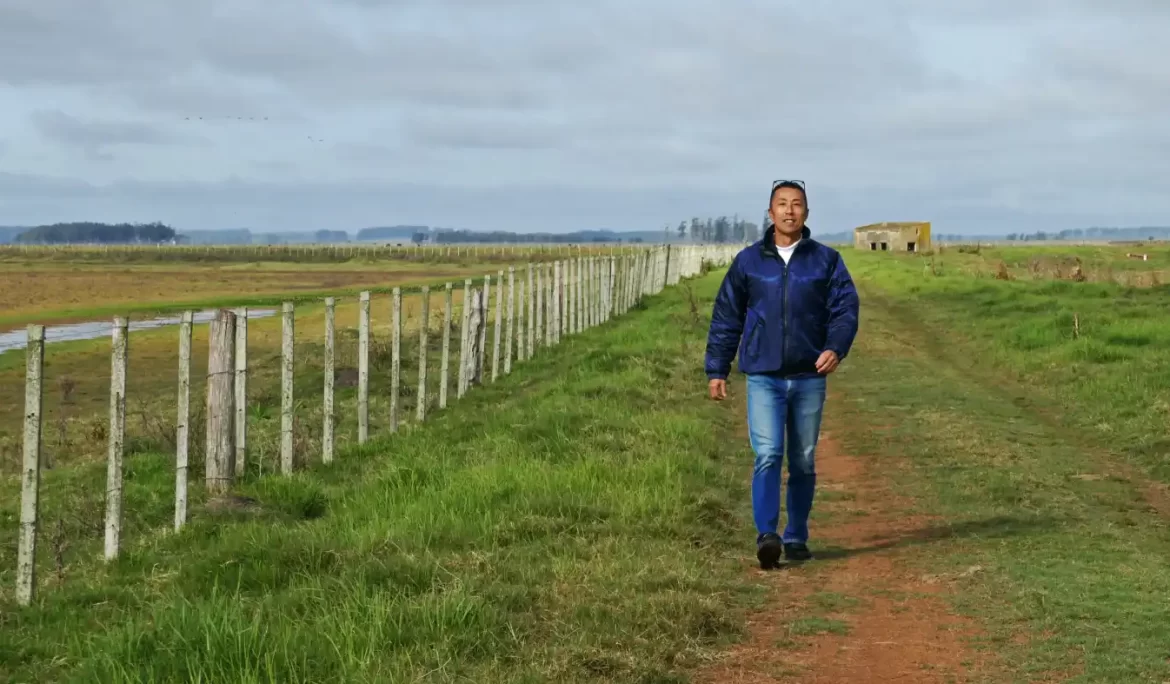New generation opens up markets with japonica rice and wine
LA CORONILLA, Uruguay — Shigenao Tamura was 22 in 1995, fresh out of Hiroshima University with a degree in agronomy.
He had never left Japan but was keen to learn about farming practices overseas. So when he was offered a one-year unpaid position at a Japanese family-owned farm called Agridiamond in Uruguay, he packed his bags and traveled more than 19,000 kilometers to La Coronilla, a sleepy oceanside farming town on the Atlantic coast.
He did not speak Spanish and life was nothing like it was at home. He was given a bunk in quarters without electricity and mutton stew was the daily fare. He was on horseback from sunrise to sunset.
“That first year took a toll on me. I would gather eggs from seabirds because I could not deal with eating mutton every day. I think I went to bed crying every night,” said Tamura.
After a year, however, he was offered a paid position and decided to stay. He eventually married a local woman and started a family.
Fast forward 30 years, he is now director of Agridiamond, which has become a major supplier of japonica rice to neighboring South American countries. Agridiamond’s sister company Cerro del Toro produces wines that are distributed around the world.
Instead of riding a horse, Tamura now drives a truck. He no longer eats mutton for breakfast, but is hooked on mate, the well-known hot beverage slurped by many in Uruguay and neighboring countries. He is the only Japan-born member of Agridiamond’s team today.
“I got used to living here and prefer it. I could not live in a city. It is so quiet here,” said Tamura.
The flat, open countryside and peace of rural Uruguay is indeed what initially attracted a group of Japanese looking for new lands to settle in and produce food with the idea of exporting it back home.
Agridiamond got its start in a circuitous way. Founding father Hideo Kambara first headed to Papua New Guinea after World War II to look for farming opportunities outside Japan. The Pacific Island nation was closer to home but did not offer the kind of land he wanted. He started looking farther afield, setting his sights on South America.
The group of Japanese first arrived in Paraguay in 1956 and then went to Brazil, but securing farmland was not easy. Argentina followed a few years later but political and economic upheaval led them to look elsewhere.
Next door Uruguay turned out to be the logical choice as the government allowed them to acquire as much as 24,000 hectares of land close to the border with Brazil.
In 1974, Kambara and his family settled in and started growing long-grain rice and raised livestock to export to Japan.
Tamura arrived as Agridiamond moved into production of japonica rice. His university studies in agricultural production in Japan were a major factor in his being recruited to the farm.
Initially, the rice was exported to Japan but tariffs and shipping costs made that a money-losing endeavor.
Luckily for the company, the world’s largest Japanese diaspora was living in neighboring Brazil. The Japanese population there currently numbers more than 2 million people. While Brazil did grow rice, it did not produce japonica.
Agridiamond quickly became Brazil’s top supplier of japonica rice. Of the roughly 7,000 tons of rice it produces annually, 70% goes to Brazil. The rest is shipped to Europe and the U.S., with a small percentage staying in Uruguay.
Agridiamond’s Mirokumai rice is used in hundreds of Japanese restaurants in Brazil. The local subsidiary of major Japanese food group Kikkoman uses it to make its Azuma brand of sake in Brazil.
“We have benefited from the boom in Japanese cuisine in Brazil and other countries,” said Tamura. “Thanks to demand and shipping prices, we are opening new markets.”
After all these years, Tamura said he is still in awe at the size of Agridiamond’s operations, compared to what he knew in Japan.
“There are no farms of this size in Japan. The land is flat, which makes it easy to cultivate. We have opportunities here that you do not see in agriculture in Japan,” he said.
Uruguay has 140,634 sq. km of farmland, compared to 43,720 sq. km in Japan, according to the World Bank. The U.S. Department of Agriculture (USDA) ranks Uruguay as the world’s eighth-biggest exporter of rice globally and first among South American countries. It had 167,913 hectares planted with rice last year and shipped 7,200 tons from the 2022/2023 harvest.
Agridiamond’s farm currently covers 17,000 hectares, though only 8,000 hectares is for farming. The remaining land was classified as part of a Ramsar site, a U.N. recognized protected wetland, and is off limits. The wetlands are home to more than 200 bird species.
Uruguay is also a major beef producer, ranked 15th worldwide and fourth in South America — after Brazil, Argentina and Colombia — according to the USDA. Agridiamond has 7,000 head of cattle, with beef destined for sale locally and internationally.
Meanwhile, sister company Cerro del Toro has been producing wines since 2018 in Piriapolis, a small town in the coastal Maldonado department, roughly 200 km southwest of La Coronilla.
Its history is similar to that of Agridiamond. When the Kambara family purchased 800 hectares of land in the town in the 1980s they looked into various businesses, including a retirement settlement for elderly people from Japan. However, distance and language worked against that idea.
“For more than 30 years they patiently studied different options until 2015, when they made the decision to plant the vines,” said Martin Lopez, Cerro del Toro’s CEO. The Kambaras partnered with Norwegian businessman Lars Ugland and set up a local team to start the business.
Cerro del Toro’s 28 hectares of land is planted with 11 varieties of grapes, from the tannat, a deep red grape that takes its name from its high level of tannins, to the lively and light albarino white grape that is its current star. “Being right in front of the ocean defines Cerro del Toro [wine’s] personality,” said Lopez.
In 2018, Cerro del Toro’s first batch of wines was presented to the Japanese embassy in Uruguay. Japan became its first shipping destination when commercial sales started the following year. Today, around 40% of its annual production of 220,000 bottles goes to Japan.
Lopez said the decision to focus on albarino grapes at the start was “genius,” helping to open doors quickly. “It is a variety that works well and in a very short time, gained acceptance by consumers. We are opening new markets each year,” he said. In 2022, the albarino white wine was selected by Sweden’s alcohol retail monopoly Systembolaget for official distribution in the country.
Cerro del Toro is getting ready for its next big step, which is to build its own winery. Currently, it rents space for winemaking and bottling. Lopez said that the company wants to have the means for the full production cycle — from vines to bottling — located on its own property.
Statistics back up the idea. While Uruguay is a wine-producing country, with 15 of its 19 departments having vineyards, Maldonado is seeing the fastest growth in new planting and new wineries. Hectares planted with grapes went from around 20 at the start of the century to 400 last year. “The future of wine in Uruguay is in Maldonado,” Lopez said.

